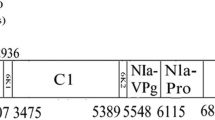Abstract
Many viral diseases of sugarcane negatively affect yield. A sugarcane accession originating from South Africa exhibiting mosaic symptoms was processed for high-throughput sequencing. Bioinformatic analysis revealed two known sugarcane viruses and a contig of around 2,800 nucleotides resembling umbra-like viruses of the family Tombusviridae. The sequence of the viral contig was confirmed by cloning and Sanger sequencing, and the ends of the virus sequence were determined. Open reading frame analysis revealed the presence of four ORFs. Phylogenetic analysis of the complete virus sequence showed that this virus clusters with other umbra-like viruses of the family Tombusviridae.


Similar content being viewed by others
Availability of data and material
The full genome sequence of sugarcane umbra-like virus has been deposited in the GenBank database under accession no. MN868593.
References
ElSayed AI, Komor E, Boulila M, Viswanathan R, Odero DC (2015) Biology and management of sugarcane yellow leaf virus: an historical overview. Arch Virol 160:2921–2934
Koike H (1974) Interaction between diseases on sugarcane: sugarcane mosaic and ratoon stunting disease. In: Proceedings of international society of sugar cane technology, pp 258–265
Braidwood L, Müller SY, Baulcombe D (2019) Extensive recombination challenges the utility of sugarcane mosaic virus phylogeny and strain typing. Sci Rep 9:20067
Mahuku G, Lockhart BE, Wanjala B, Jones MW, Kimunye JN, Stewart LR, Cassone BJ, Sevgan S, Nyasani JO, Kusia E, Kumar PL, Niblett CL, Kiggundu A, Asea G, Pappu HR, Wangai A, Prasanna BM, Redinbaugh MG (2015) Maize lethal necrosis (MLN), an emerging threat to maize-based food security in Sub-Saharan Africa. Phytopathology 105:956–965
Syller J (2003) Molecular and biological features of umbraviruses, the unusual plant viruses lacking genetic information for a capsid protein. Physiol Mol Plant Pathol 63:35–46
Taliansky ME, Robinson DJ (2003) Molecular biology of umbraviruses: phantom warriors. J Gen Virol 84:1951–1960
Quito-Avila DF, Alvarez RA, Ibarra MA, Martin RR (2015) Detection and partial genome sequence of a new umbra-like virus of papaya discovered in Ecuador. Eur J Plant Pathol 143:199–204
Sá Antunes TF, Amaral RJV, Ventura JA, Godinho MT, Amaral JG, Souza FO, Zerbini PA, Zerbini FM, Fernandes PMB (2016) The dsRNA virus papaya meleira virus and an ssRNA virus are associated with papaya sticky disease. PLoS ONE 11:e0155240
Felker P, Bunch R, Russo G, Preston K, Tine JA, Suter B, Xiaohan M, Cushman JC, Yim WC (2019) Biology and chemistry of an Umbravirus like 2989 bp single stranded RNA as a possible causal agent for Opuntia stunting disease (engrosamiento de cladodios)—a review. J Prof Assoc Cactus Dev 21:1–31
Tahir MN, Lockhart B, Grinstead S, Mollov D (2017) Characterization and complete genome sequence of a panicovirus from Bermuda grass by high-throughput sequencing. Arch Virol 162:1099–1102
Miller WA, Dinesh-Kumar SP, Paul CP (1995) Luteovirus gene expression. Crit Rev Plant Sci 14:179–211
Nguyen Ba AN, Pogoutse A, Provart N, Moses AM (2009) NLStradamus: a simple Hidden Markov Model for nuclear localization signal prediction. BMC Bioinform 10:202
Ryabov EV, Robinson DJ, Taliansky M (2001) Umbravirus-encoded proteins both stabilize heterologous viral RNA and mediate its systemic movement in some plant species. Virology 288:391–400
King AM, Lefkowitz E, Adams MJ, Carstens EB (2011) Virus taxonomy: ninth report of the International Committee on Taxonomy of Viruses. Elsevier, Amsterdam
Kumar S, Stecher G, Li M, Knyaz C, Tamura K (2018) MEGA X: molecular evolutionary genetics analysis across computing platforms. Mol Biol Evol 35:1547–1549
Funding
This work was supported by the United States Department of Agriculture, Agricultural Research Service.
Author information
Authors and Affiliations
Contributions
Conceptualization: DM, MNT. Methodology: MNT, SCG. Formal analysis and investigation: MNT, SB, DM. Writing—original draft preparation: SB, DM, MNT, SM. Writing—review and editing: SB, DM, MNT, SM, SCG. Funding acquisition: DM. Resources: DM, SM. Supervision: DM.
Corresponding author
Ethics declarations
Conflict of interest
We report no conflict of interest.
Ethics approval
All plant material was imported under USDA APHIS PPQ permits.
Additional information
Handling Editor: Massimo Turina.
Publisher's Note
Springer Nature remains neutral with regard to jurisdictional claims in published maps and institutional affiliations.
Supplementary Information
Below is the link to the electronic supplementary material.
Rights and permissions
About this article
Cite this article
Tahir, M.N., Bolus, S., Grinstead, S.C. et al. A new virus of the family Tombusviridae infecting sugarcane. Arch Virol 166, 961–965 (2021). https://doi.org/10.1007/s00705-020-04908-9
Received:
Accepted:
Published:
Issue Date:
DOI: https://doi.org/10.1007/s00705-020-04908-9




